You can usually make the transformation far better than the camera can.
This article is now outdated and due for a rewrite. You can find an updated B&W presentation from B&H Event Space here. That two-hour presentation covers everything here and a lot more about converting images to B&W. I'll eventually get around to updating this article.
Most digital cameras have a black and white shooting mode. However, this usually does nothing more than create identical Red, Green, and Blue channels in the final picture file. Black and white film aficionados generally find the results from digital cameras lacking, though—you can do much better in Photoshop.
You could, for instance, convert the mode from RGBColor to Grayscale. When you use this technique, Photoshop applies a set of defaults to the transition. I find that these tend to be a little too low in contrast for my taste.
Or you could simply choose Desaturate and take all the color out of the image. This technique also tends to produce an image that still needs work, though. You'll find it difficult to achieve rich, deep blacks and a long range of gray detail.
Another choice is to convert the image to Lab Color mode, and then delete the A and B channels (the two channels that contain the color information). Note that when you delete the first color channel, the channels get renamed--it still should be obvious which one is the Lightness channel, though (the remaining color channel will be quite dark).
But the best way to achieve outstanding black and white photos without a dedicated plug-in is to use Photoshop's channel mixer abilities to act as a digital set of black and white filters. Before we get to the instructions, let's look at the three channels you'll be working with:
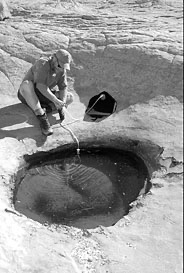
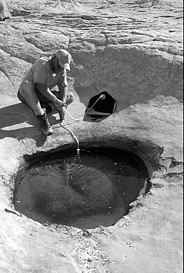
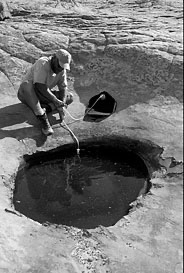
From top to bottom, the Red channel, Green channel, and Blue channel. It's worth looking at the three individually, as it gives you some idea of how you might want to mix them. For example, we need the Red channel to define Steve's skin tones, the Blue channel to define the rock behind Steve. In this particular picture, the Green channel doesn't help us much, so the balance between the Red and Blue channels will be the ones to watch closely.
The steps for using the Channel Mixer go like this:
- Take your pictures in color, as usual. Be especially careful not to let highlight detail get overexposed. Do not blow out a channel! This is even more important for images that get converted to black and white, as you'll want significant detail in the light grays of your final image, and you don't want to limit any channel's ability to help you in that regard.
- Start up Photoshop and open the image you want to convert. Choose Open from the File menu, navigate to your image and open it.
- Convert the image to black and white. Select Channel Mixer from the Adjust submenu on the Image menu. In the mixer, click on the Monochrome box at the bottom, then adjust the Red, Green, and Blue channels. The balance of the three channels is your "digital filter" tray, so don't be afraid to adjust each channel individually until you find the right balance for your image. I often find that I want to be aggressive on the Red channel, less aggressive on the Green channel. (Note that with high ISO values or long exposures, you may have to deal with noise in one or more of the channels before making your conversion. On Nikon bodies, this is usually the Blue channel, but in some lighting conditions, the Red channel can be overly noisy, as well.) Your values for the three channels should normally add up to 100%. You can use negative numbers for channel values, too, so you could have 80%, -20%, 40% as a conversion value.
- Finish your adjustments. Normally, I’d try the Auto Contrast or Auto Levels controls first, just to see what effect they produce (don't scoff, in black and white these automated controls work a bit better than they do in color). If these controls didn’t achieve the rich range of grays I was looking for, then I’d use Curves (all on the Adjust submenu of the Image menu). However, for a much more subtle approach, use Selective Color and work with the Blacks, Neutrals, and Whites. This gives you a way to deal with the shadows, mid-tones, and highlights separately.
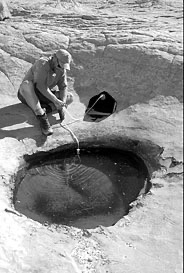
Above is my first pass using Channel Mixer. I've intentionally reduced the contrast somewhat (I tend to like to apply Curves to balance against what my printer does in black and white). Below is my final pass using the Color Mixer (I also moved the white and black points slightly).
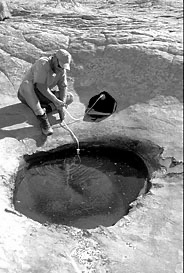
One thing you should notice is the additional contrast I picked up in the rock. The photo on the right looks "sharper" than the one of the left, but believe it or not, I've made no changes other than channel balance and setting white and black points. (I sharpened the color original before making the black and white conversions, but I did not apply any additional sharpening after the conversions.)
Another technique that is useful comes from Photoshop expert Russell Brown:
- Create a Hue/Saturation Adjustment layer above your original. Set the Blend mode to Color.
- Create a second Hue/Saturation Adjustment layer above the other two. Set the Saturation to -100.
- Now go back and move the Hue slider in the layer you created in Step 1; as you do, you'll see the image change as the desaturation is applied to differing values. You can go in and use individual channels (from the drop down menu) if you'd like. Explore!
- Add a Levels Adjustment layer on top of the stack you've already got if you need to change contrast and brightness.
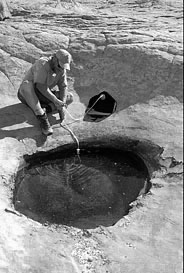
Above is what the Russell Brown approach yielded me with a quick and dirty appraisal. Note the nearest foreground is retaining more texture than in some of the other examples, though I wasn't able to get that without losing some of the brightness in Steve's skin tones. Remember, you can play with individual channels (Hue and Lightness should both be tried) or the Master channel in the first layer you created.
All that said, there's a better way if you're willing to spend a bit of extra dough: the Nik Silver Efex Pro plug-in. While you'll have another program to learn, you'll find that Silver Efex Pro provides a plethora of choices and can pull out detail that's hard to match with any of the simple methods I outline above.
So let's look at some results:
Note: I haven't made any adjustments on these pictures other than the conversion to black and white. Usually, you'd play with Curves and Contrast a bit after making the transition.
Here's our original color image. (Steve Howe, BACKPACKER Rocky Mountain editor getting our evening's water supply in Capital Reef National Park).
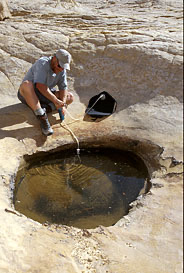
Photoshop's Grayscale conversion. Note the lack of contrast in the rocks behind Steve.
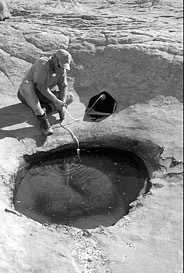
Desaturation produces a bit more contrast, and gives us a better starting point than Grayscale.
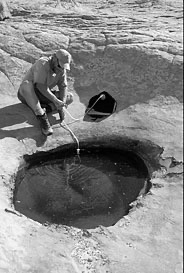
I like the Lab Color conversion because it usually produces images that are easier to work with. Compare the shadow areas on Steve's shirt in this version compared to the others. Skin tones tend to look lighter and more natural, as well.
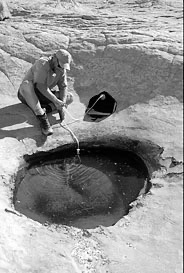
But Silver Efex Pro allowed me to do something very different with same scene, punching the detail in the rocks (exaggerated here for impact).
